|
Chinese Seals
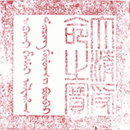 |
|
The Qing dynasty (1644-1911) with inscription in Chinese
(left) and Manchu (right) | The role of seals in the
Chinese culture can hardly be underestimated. For the last 3,000 years they have
been used in both official and private spheres. The earliest examples of seals
come from the Shang dynasty (c. 16th - 11th century BC) from the archeological
sites at Anyang. However, very little is known about their usage at this early
stage, it is only starting from the Spring and Autumn period (770-476BC) that we
begin to see an increased quantity of seals paired with textual references to
them. According to a Han dynasty story, the first seal was given to the Yellow
Emperor by a yellow dragon with a chart on its back. Another story says that it
was given to Emperor Yao by a phoenix as the emperor was sitting in a boat. In
any case, the receipt of the seal signifies the conferral of the Mandate of
Heaven. He who has the seal possesses the Mandate of Heaven, in other words, he
has been given the right to rule the empire. So when Tang, the first ruler of
the Shang dynasty overthrows the last tyrant of the previous Xia dynasty, he
seizes the royal seal and thus establishes his power.
Official imperial seal from the Qing dynasty (1644-1911) with inscription in
Chinese (left) and Manchu (right)
 Imperial seals Imperial seals
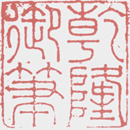 |
|
Seal of the Handwriting of Emperor Qianlong
(1736-1795) | Until the end of Warring States period
(BCE 403-221), there was only one way of calling seals, both official and
private, regardless of their use and material. This name was xi, which in the
following periods gradually became the designation for imperial seals. According
to the History of Tang dynasty, Empress Wu (634-705) issued an order to change
the word xi, which was up until then used for imperial seals, to bao (treasure).
Apparently, she disliked the fact that the word xi was close in sound to the si
(death). But when Emperor Zhongzong resumed the throne in 705, he changed the
name for imperial seals back to xi. In subsequent centuries the two words were
alternated, depending on the period.
At the time of the Han dynasty, the emperor had six seals, during the
Tang he had eight, during the Ming over a dozen, and by the time of the Qing,
there were several dozens of official imperial seals. The inscription on these
official seals usually refers to receiving the Mandate of Heaven or being the
successor of Heaven.
Another type of imperial seal was a seal that the emperor used to indicate
that a certain document was written in his own handwriting. Emperor Qianlong
(1736-1795) for example, was famous for his literary ambitions, including
calligraphy, and had produced a large amount of texts affixed with his seal.
When his calligraphy was carved into stone steles, the seal was copied onto the
surface of the stone too.
Yet another seal was used by the emperors to appraise and appreciate art. It
was customary for collectors and connoisseurs of art to affix their seals on the
surface of a scroll of painting or calligraphy. The paintings acquired by the
imperial household were affixed by the imperial seal. Many famous paintings from
the Forbidden City have seals of generations of subsequent emperors on them.
 Official Seals Official Seals
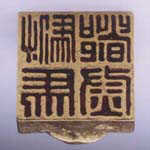 |
|
Official seal of the Coach Attendant Eastern Han period
(25-330) |
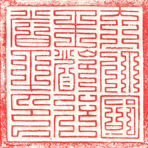 |
|
Official seal with the so-called "nine-fold"
script | Official seals have been conferred to
officials as a token of their office and authority. These seals were usually
small enough to be carried on the official's belt. There were regulations as to
the material and shape of the handle of these seals: some had to be golden, some
copper, some with a handle in the shape of a turtle, some of a camel. Up to the
Eastern Han dynasty (25-330), the color of ink used to affix official seals was
regulated depending on the position of the owner, some officials had to use
green ink, some purple, some yellow etc.
The calligraphy of the inscription had changed a great deal over the long
span of Chinese history. Approaching the Han dynasty, the characters on the seal
inscriptions tend to become thicker and more angular. From the Sui dynasty
(581-618), they become rounded and thinner, and during the Song and Yuan periods
we can witness the spectacular jiudie (nine-folded) script. In the Qing period,
most official seals are bilingual with the Chinese inscription on the right side
and the Manchu on the left.
 Private Seals Private Seals
Private seals are naturally unregulated; therefore they show the largest
variety in content, shape, size, material and calligraphy. Despite their varied
characteristics, they can still be categorized based on their use.
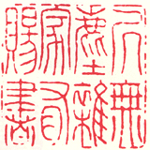 |
|
Leisure Seal | Seals with names, pen
names, pseudonyms etc on them were used as a signature by people in their
private life. This is how artists sign their works and letters. Chinese literati
commonly used a number of different pen names so identifying a person's name
from a seal can be a tricky business.
Collector seals were mainly used for the purpose of authenticating pieces of
art. Thus a seal of a famous collector or connoisseur would become an integral
part of a work of art and could substantially raise its value. Thus in the
course of several centuries, some Chinese paintings became covered by a dozen of
different seals.
The rest of private seals can be conveniently categorized under the umbrella
term "leisure seals". The inscription on these seals is usually a short text
which is either a quote from a famous writing or just some saying that the owner
thought important. Typical inscriptions are "Respect fate", "Attain wisdom",
"Respect", "Use loyalty and humanity in your affairs" etc. One could compare
these seals to signatures with a quote at the end of email messages where the
people append some saying they consider valuable at the end of their message.
|
|


 Imperial seals
Imperial seals

 Official Seals
Official Seals


 Private Seals
Private Seals
